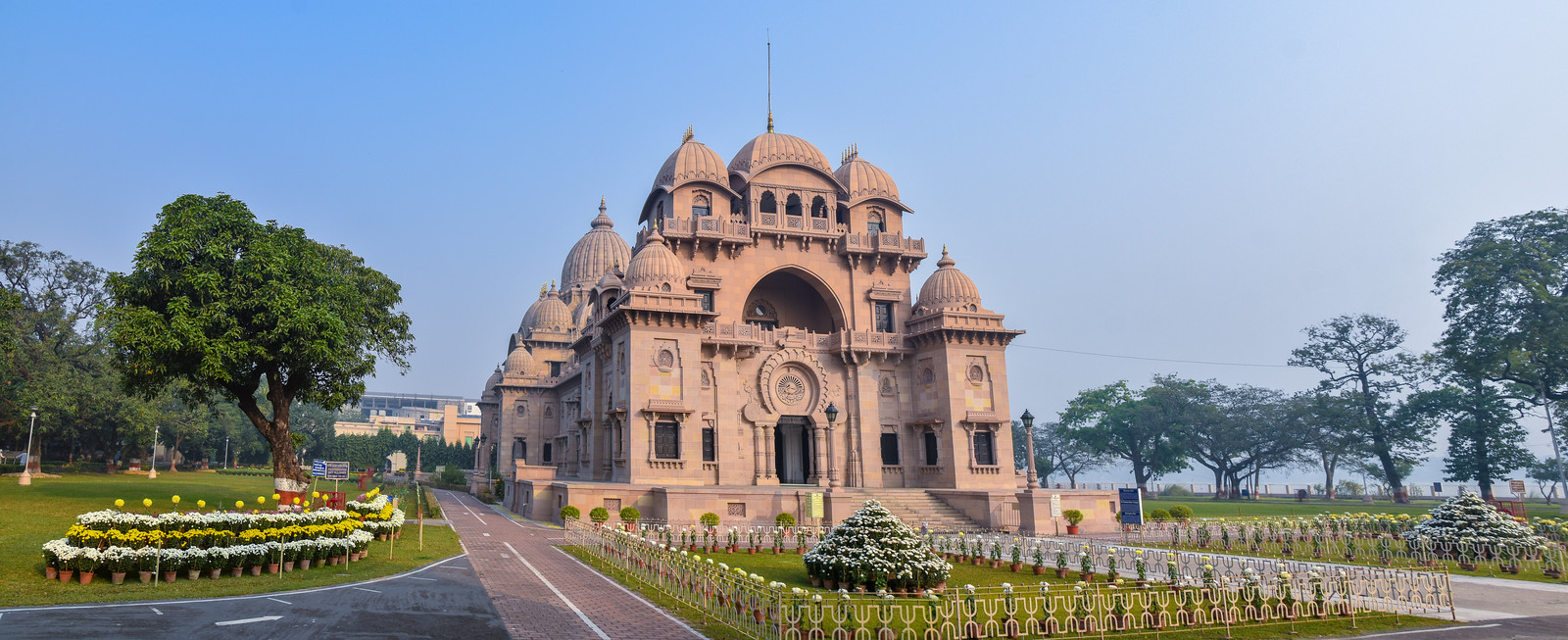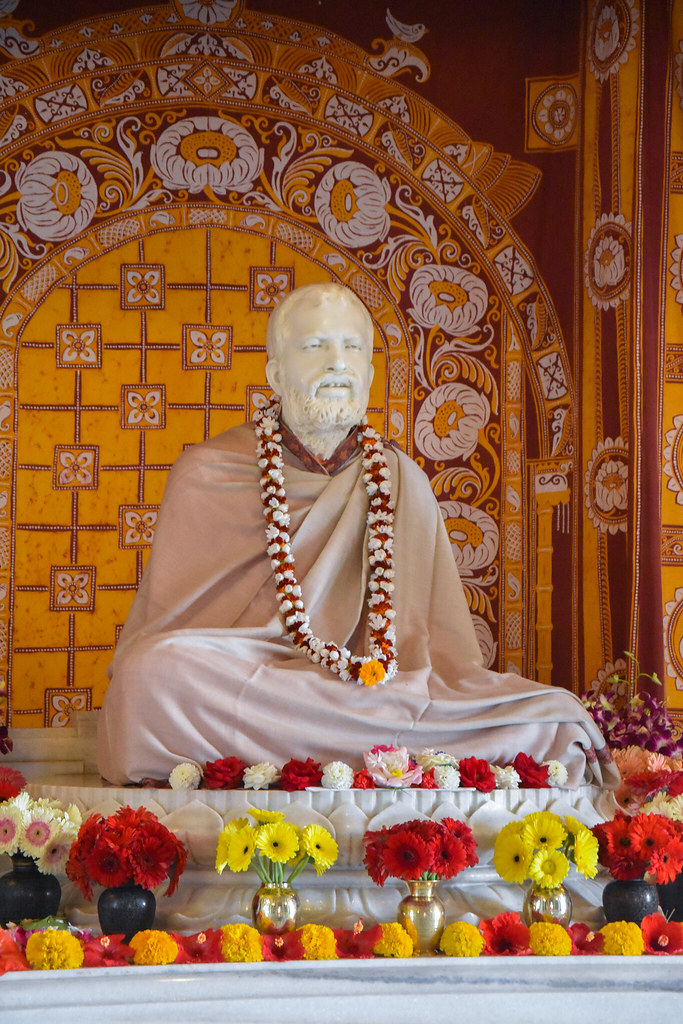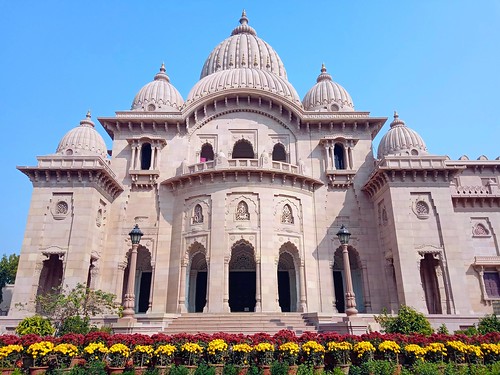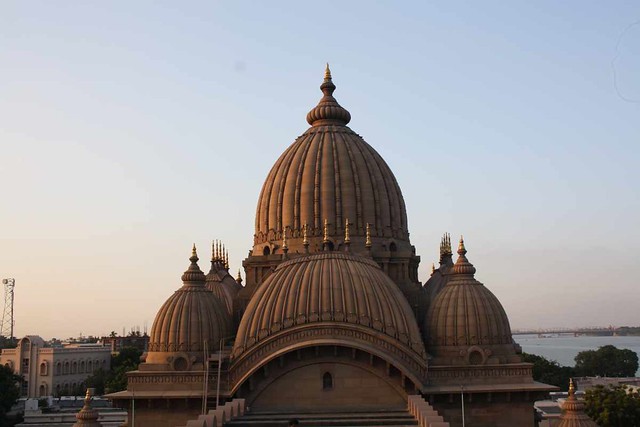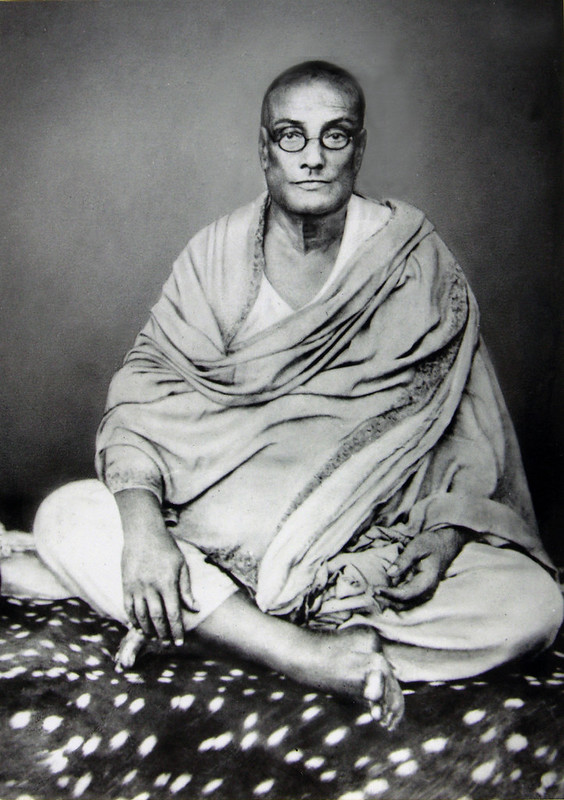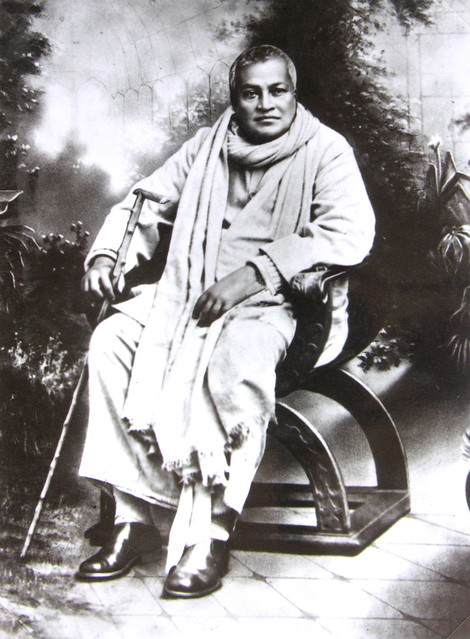The awe-inspiring majesty of the temple coupled with its austere simplicity spontaneously kindles devotion in us. As we climb the steps of the main entrance and behold Sri Ramakrishna seated on a lotus in his majestic glory, we are reminded of the Vedic hymn ‘O King of kings! O granter of success and wealth! We offer our salutations to you!’
What Swami Shivananda said about the earlier temple echoes in our ears: ‘This is our shrine. Sit here for a while and do japa. Sri Ramakrishna is present here fully awakened; he sees and hears everything; … pray to him for bhakti, mukti, wisdom, power of discrimination, dispassion, liberation or money, power, pleasures of life or anything; you will get whatever you want.’
We sit for a while in silent prayer before Sri Ramakrishna.
The sanctum is serene and austere, devoid of any ornate decoration, befitting the ideal of Sri Ramakrishna. He is sitting on a full-bloomed lotus sculpted in white Italian marble. The rectangular altar below is curved in the middle like the damaru of Shiva. The front, left and right sides of the altar have a hamsa engraved on them. The sacred dust of Mother’s feet is preserved and worshipped in a niche on the eastern wall, to Sri Ramakrishna’s left. In the niche on the western wall is a small Shivalinga, known as Baneshvara Shiva, which is worshipped every day.
The frame of the beautiful canopy over the altar is made of teakwood. The canopy is adorned by Om in Sanskrit. The doors of the sanctum were fashioned by a Chinese carpenter. Sri Ramakrishna is known to the world as the Prophet of harmony. Swamiji envisaged the Great Master’s temple as an expression of his message of harmony. A closer look at its features can enable us to see how this idea of harmony has found expression in this grand temple. The temple blazes a new trail in temple architecture with a blend of Eastern and Western architectural styles. The sanctum (garbha-griha) is connected to the prayer hall (natmandir) by a closed vestibule, making the structure resemble a church. This is unique in Indian temple architecture. Temples of yore have no common prayer halls, where people could gather and attend the worship. The arched ceiling, hanging balconies and the two rows of stately pillars are all reminiscent of the Buddhist caves in the Great Chaitya Hall at Karla near Mumbai. The windows and the arches around the sanctum are after Rajput and Moghul styles.
A little above the emblem is a Shivalinga. There is a special significance of Shivalinga in Sri Ramakrishna’s life: his mother Chandramani Devi felt that she was with child after a flood of divine light emanated from a Shivalinga entered into her.
Brief History
It was Swamiji’s lifelong desire to preserve the mortal remains (holy ashes) of Sri Ramakrishna and enshrine it in a grand temple dedicated to him. This could not happen during Swamiji’s lifetime. So he installed Sri Ramakrishna in what is now known as the ‘old temple’. However, before leaving his body, Swamiji had a plan ready for a monumental temple. Following his directions, Swami Vijnanananda, his brother disciple and a qualified civil engineer drew the plan. Though Swamiji did not live to see this temple, he assured that he would see it from ‘above’.
The foundation stone for the temple was laid by Swami Shivananda on 13 March 1929, Sri Ramakrishna’s birthday. For paucity of funds, the construction could not begin immediately. It started only after five years with substantial contributions from Miss Helen Rubel (also known as Bhakti) and Mrs. Anna Worcester (also known as Annapurna). By their munificence, these two American devotees have become inseparably connected with the history of Ramakrishna Math and Ramakrishna Mission, and have endeared themselves to all devotees of Sri Ramakrishna.
Before the construction began, the foundation site had to be shifted about a hundred feet from the original spot, as advised by engineers. Swami Vijnanananda, the then president of the Order, re-laid the foundation on 16 July 1935, the day of Guru-purnima. In the morning, he went to the shrine to seek Sri Ramakrishna’s blessings. The auspicious time fixed for laying the foundation was 8.15 am. He was known for his punctuality, but that day he spent a long time in the shrine. It was past 8.30 a.m. when he came out of the shrine. When asked about the delay he said, ‘What I shall do! Sri Ramakrishna did not allow me to take leave of him.’
On the foundation day too something mysterious happened. At the beginning of the ritual, Swami Vijnanananda stood in front of the picture of Sri Ramakrishna, decorated for the purpose, holding in his hands the arghya (flowers, sandal paste, vilva leaf, and so on) to be offered to Sri Ramakrishna. Then blew a gentle breeze that displaced the arghya from his hands and placed it right on the spot where it was to be offered to Sri Ramakrishna. It was as if Swamiji had offered this first arghya to the Master. Swami Vijnanananda then offered another arghya to the Master.
The new temple was dedicated by Swami Vijnanananda on 14 January 1938, the day of Makara Sankranti. After the dedication he said: ‘I had said to Swamiji, “Swamiji, you told me that you would witness the temple dedication from above. Here, behold! Sri Ramakrishna, whom you have installed, is seated in the new temple, which is built according to your own design.” Then I distinctly saw there (showing the south-western direction) Swamiji, Brahmanandaji, Mahapurushji, Saradanandaji, Turiyanandaji and Akhandanandaji—all joyfully watching and blessing the dedication!’
About the presence of Sri Ramakrishna in Belur Math, Swami Shivananda observed: ‘Sri Ramakrishna is living here in all his glory. We live in his presence always as we lived and talked with him in Dakshineswar. By his presence, the mind is brimming with bliss.’ Sri Ramakrishna’s disciples were particular that the novices at Belur Math were always conscious of Sri Ramakrishna’s eternal presence at Belur Math. Swami Shivananda once admonished a young swami for his carelessness while preparing fruit offering to Sri Ramakrishna: ‘What kind of service is this! You have not removed the fibres properly from the bananas and oranges. Be careful not to commit mistakes while serving Sri Ramakrishna. He is living, so worship him with great care. He is accepting the worship; I see it.’
Swamiji too had emphatically said, ‘The Lord has not yet given up the Ramakrishna form. Some see Him in that form even now and receive instructions from Him, and all can see Him if they so desire.’
Also See : Ramakrishna Temple : A Symphony in Architecture
It was Swami Vivekananda’s desire that the Ramakrishna Temple should embody the salient features of major temple architecture of different religious beliefs so that everyone who comes to this temple would feel at home and realise the underlying principle of the universal brotherhood and religion propounded by Sri Ramakrishna.

